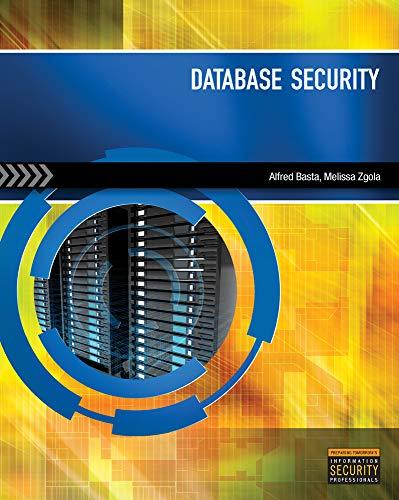Question
python3 (3a) Write a function, frequent, with one parameter, psw, a string. If psw is in a list of frequently used passwords ['password', '12345', 'qwerty',
python3
(3a) Write a function, frequent, with one parameter, psw, a string. If psw is in a list of frequently used passwords ['password', '12345', 'qwerty', 'letmein', 'trustno1', '000000', 'passw0rd'], frequent should return False; otherwise, return True. Be sure to include at least three good test cases in the docstring.
(3b) Password Protection SecuriCorp has recently been the victim of a number of security breaches. Internal analysis has determined that employees use simple passwords that are too easy to guess. You have been hired to write a password checking program. This program should contain a function passwordChecker which takes a password and returns one of the following security regulation codes: Passwords must be at least 5 characters long Passwords must contain at least one upper case letter Passwords must contain at least two numbers Passwords may not contain the characters "E" or "e" Passwords must include at least one non-alphanumeric character. A password may not be a frequently used password: 'password', '12345', 'qwerty', 'letmein', 'trustno1', '000000', 'passw0rd' Consultants suggest writing a separate function to test a password against each of these conditions.
These functions could then be called from the passwordChecker function. However, implementation details are left to you.
reference code:
# problem 1
# problem 1a
def checklen(astring, le):
'''
(str) -> Boolean
Returns True if length of astring is at
least le characters long, else False
>>> checklen('', 1)
False
>>> checklen('four', 5)
False
>>> checklen('check', 5)
True
>>> checklen('check6', 6)
True
'''
return len(astring) >= le
# problem 1b
# empty string needs to be treated
# as a separate condition
def is_nonalnum(astring):
'''
(str) -> Boolean
Returns True if astring contains at
least one non-alphanumeric character;
returns False otherwise.
>>> is_nonalnum('')
False
>>> is_nonalnum('abc123')
False
>>> is_nonalnum('#123')
True
'''
if len(astring) == 0:
return False
else:
return not(astring.isalnum())
# problem 1c
# if vs. elif - either is ok here
# return True must be outside of for-block!
def is_noEe(astring):
'''
(str) -> Boolean
Returns True if astring does NOT
contain characters 'E' or 'e';
returns False otherwise.
>>> is_noEe('')
True
>>> is_noEe('e')
False
>>> is_noEe('CHEM 101')
False
>>> is_noEe('abcd')
True
'''
if 'E' in astring:
return False
elif 'e' in astring:
return False
else:
return True
# prolbe 1c
# different algorithm/same solution
"""
def is_noEe(astring):
'''
(str) -> Boolean
Returns True if astring does NOT
contain characters 'E' or 'e';
returns False otherwise.
>>> is_noEe('')
True
>>> is_noEe('e')
False
>>> is_noEe('CHEM 101')
False
>>> is_noEe('abcd')
True
'''
lowere = 'e' in astring
uppere = 'E' in astring
return not(lowere or uppere)
"""
# problem 1d
def is_uc_alpha(astring):
'''
(str) -> Boolean
return True if any char in s is an
uppercase letter, otherwise return False
>>> is_uc_alpha('CIS122')
True
>>> is_uc_alpha('Ducks')
True
>>> is_uc_alpha('testing')
False
'''
for c in astring:
if c.isupper():
return True
return False
# problem 1e
def is_2numbers(astring):
'''
(str) -> Boolean
returns True if astring has at least two numbers,
otherwise return False
>>> is_2numbers('CIS122')
True
>>> is_2numbers('Ducks')
False
>>> is_2numbers('ABC-1')
False
'''
digits_ctr = 0
for c in astring:
if c.isdigit():
digits_ctr += 1
return digits_ctr >= 2
# problme 1f
def is_special_char(astring):
'''
(str) -> Boolean
returns True if string contains a
special character:!, @, #, $, %, ^, &
otherwise returns False
>>> is_special_char('CIS122')
False
>>> is_special_char('CIS-122')
False
>>> is_special_char('CIS122!')
True
'''
special = '!@#$%^&'
for c in astring:
if c in special:
return True
return False
doctest.testmod()
Write the code (passwordChecker function and auxiliary functions) and execute it for a sufficient number of test cases that SecuriCorp will be confident of their passwords.
Step by Step Solution
There are 3 Steps involved in it
Step: 1

Get Instant Access to Expert-Tailored Solutions
See step-by-step solutions with expert insights and AI powered tools for academic success
Step: 2

Step: 3

Ace Your Homework with AI
Get the answers you need in no time with our AI-driven, step-by-step assistance
Get Started


